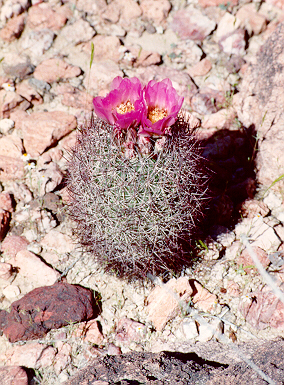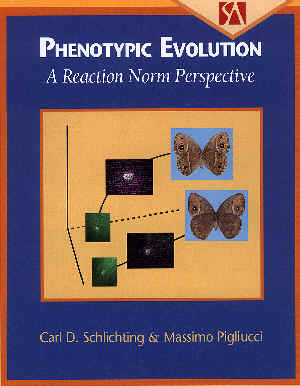




Contact Information:
Current Areas of Research:
Standard Mendelian genetics
teaches us to view living organisms as a duality: the DNA/genes constitute
the genotype, and the observable characteristics that result from
that set of genetic instructions are referred to as the phenotype.
This view neglects what happens in-between, epigenetics,
the developmental processes that translate the genetic instructions into
the visible phenotypes of organisms. My conceptual focus is on providing
ways of explaining how the relatively simple instructions contained in
the DNA for making proteins can produce the marvelously complex and integrated
organisms that populate the earth.
My research revolves around understanding
the forces that shape the evolution of the phenotype, from the perspective
of the reaction norm (i.e., the range of phenotypes that will be produced
by a genotype when it is exposed to different environments). Experimentally
I have studied the morphological responses of species and populations to
environmental variability (their phenotypic plasticity), but I have become
equally interested in the other side of the coin, namely what evolutionary
forces operate to restrict the expression of phenotypic variation (the
lack of plasticity, i.e., canalization). Some selective factors will favor
plasticity, other forces favor canalization. The reaction norm that we
observe has been forged by the balance of forces in this tension zone.
There are a number of factors that impinge on the outcome: the predictability
of environmental change, the ability to sense the change (or its correlates),
the spatial or temporal nature of variability, and the scale at which it
is perceived (e.g., within an individualís lifetime). A project to analyze
these ecological factors using Arabidopsis is in progress.
There are also historical
components to the presence/absence or form of plastic responses, and a
second project is employing a phylogenetic approach, using the comparative
method to investigate the ecological and developmental factors that determine
variation in plasticity of leaf form among species in the plant genus
Pelargonium.
This is a subset of a much larger interdisciplinary program that Dr. Cynthia
Jones and I have developed to examine the ecology and evolution of leaf
shape variability: with Adrienne Nicotra (Australian National University) we
will look at morphogenesis, plasticity, genetics and physiological
ecology of leaf shape in this incredibly diverse genus.
Book:
Phenotypic Evolution: A Reaction
Norm Perspective. C.D. Schlichting and M. Pigliucci.
1998. Sinauer Associates,
Sunderland, MA. 387 pp., 180 figures.
Selected Publications:
Pigliucci, M., and C. D. Schlichting. 1998. Reaction norms of Arabidopsis. V. Flowering time controls phenotypic architecture in response to nutrient stress. Journal of Evolutionary Biology 11:285-301.
Nicotra, A.B., R.L. Chazdon, and C.D. Schlichting. 1997. Patterns of genotypic variation and phenotypic plasticity of light response in two tropical Piper species. American Journal of Botany 84:1542-1552.
Pigliucci, M., and C.D. Schlichting. 1997. On the limits of quantitative genetics for the study of phenotypic evolution. Acta Biotheoretica 45:143-160.
Callahan, H. S., M. Pigliucci, and C. D. Schlichting. 1997. Developmental phenotypic plasticity: where ecology and evolution meet molecular biology. BioEssays 19:519-525.
Pigliucci, M., C. D. Schlichting, C. Jones, K. Schwenk. 1996. Developmental reaction norms: the interactions among allometry, ontogeny and plasticity. Plant Species Biology11:69-85.
Pigliucci, M. and C.D. Schlichting. 1995. Ontogenetic reaction norms in Lobelia siphilitica (Lobeliaceae): response to shading. Ecology 76:2134-2144.
Via, S., R. Gomulkiewicz, G. de Jong, S.E. Scheiner, C.D. Schlichting and P. van Tienderen. 1995. Adaptive phenotypic plasticity: consensus and controversy. Trends in Ecology and Evolution 10:212-217.
Schlichting, C.D., and M. Pigliucci. 1995. Gene regulation, quantitative genetics, and the evolution of reaction norms. Evolutionary Ecology 9:154-168.
Schlichting, C.D., A.G. Stephenson, L.A. Small, J.A. Winsor. 1990. Pollen loads and progeny vigor in Cucurbita pepo: the next generation. Evolution 44:1358-1372.
Schlichting, C.D., and B. Devlin. 1989. Male and female reproductive success in the hermaphroditic plant Phlox drummondii. The American Naturalist 133:212-227.
Schlichting, C.D. 1989. Phenotypic integration and environmental change. BioScience 39:460-464.
Schlichting, C.D. 1986. The evolution
of phenotypic plasticity in plants. Annual Review of Ecology and Systematics
17:667-693.
Papers in Press/Progress:
Núñez Farfán, J., and Schlichting, C.D. in revision. Evolution in changing environments: The 'synthetic' work of Clausen, Keck and Hiesey. Quarterly Review of Biology.
Núñez Farfán, J., and Schlichting, C.D. in prep. Natural selection in Potentilla glandulosa. Evolution.
Schlichting, C.D., C.J. Murren. in revision. Evolvability: definition and hypothesis testing. Evolution and Development.
Schlichting, C.D. The role of phenotypic plasticity in diversification. Chapter for Phenotypic Plasticity: Functional and Conceptual Approaches, T.J. DeWitt and S.M. Scheiner, eds.
Pigliucci, M., and C.D. Schlichting. Using candidate genes to study the mechanisms and limits of adaptations. Chapter in press for The Evolution of Phenotypic Plasticity, P. van Tienderen and P. Brakefield, eds. Cambridge University Press.
Schlichting, C.D. Phenotypic plasticity
and geographic variation in Lobelia cardinalis. In prep for
Amer. Journal of Botany.
Courses Taught:
Graduate - Evolution; Seminars in: plant evolution,
evolutionary developmental biology, plant reproductive biology
Undergraduate - Introductory Biology; Ecology; Evolution
Graduate Students:
Current:
Kathleen
Englemann: Project - Selective decoupling of morphological and life history traits in the zebrafish, Danio rerio
Former:
Courtney Murren,
Ph.D.
1999.
Dissertation:
An
ecological-genetic examination of reproduction in a tropical epiphytic
orchid across a fragmented forest habitat. Currently postdoctoral
researcher, Depts. of Botany and Ecology & Evolutionary Biology,
University of Tennessee, Knoxville.
Massimo Pigliucci, Ph.D. 1994. Dissertation: Developmental and adult phenotypic plasticity in plants: environmental induced effects on character correlations and effects on fitness. Currently, Associate Professor, Depts. of Botany and Ecology and Evolutionary Biology, University of Tennessee, Knoxville.
Jennifer Butler, M.S.
1997. Plasticity in diploid and tetraploid
Clarkia
species.